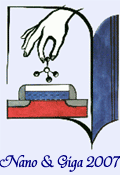
From Atoms to Materials to Devices to System Architecture
Symposium and Spring School (Tutorial Lectures)
Phoenix, Arizona, March 12-16, 2007

 |
Nano and Giga Challenges in Electronics and Photonics From Atoms to Materials to Devices to System Architecture Symposium and Spring School (Tutorial Lectures) Phoenix, Arizona, March 12-16, 2007 |
 |
|
|
Commentary
Nanoelectronics generally refers to nanometer scale devices, circuits, and architectures impacting continued scaling of information processing systems, including communication and sensor systems, as well as providing an interface between the electronic and biological worlds. The present attention on nanotechnology and nanoelectronics has been driven from the top down by the continued scaling of semiconductor device dimensions into the nanometer scale regime. It is predicted that the scaling down of dimensions in present semiconductor technologies will continue for the next 10-12 years, until a hard limit of Moore's Law is finally reached due to manufacturability, or finally due to reaching atomic dimensions themselves. By the end of that time it will be necessary for radical new technologies to be introduced if continued progress in reducing device dimensions and increasing chip density is to be maintained. This end of the roadmap implies that industry faces an enormous challenge of developing commercially viable nanoscale chip technologies within the next 10 years. Fundamental advances are needed in new switching mechanisms, new computing paradigms realized from locally connected architectures such as cellular nonlinear networks (CNN), new ways to design for fault tolerance, new methods to achieve low power circuit design, and new methods for testing very dense and highly integrated nanoscale systems-on-a-chip. From the molecular scale side or bottom up, the nanotechnology revolution has been enabled by remarkable advances in atomic scale probes and nanofabrication tools. Structures and images at the atomic scale have been made possible by the invention of the scanning tunneling microscope, and the associated atomic force microscope. Such scanning probe microscopy (SPM) techniques allow atomic scale resolution imaging of atomic positions, spectroscopic features, and positioning of atoms on a surface. Concurrently, there have been significant advances in the synthesis and control of self-assembled systems, semiconductor nanowires, molecular wires, novel states of carbon such as fullerenes and carbon nanotubes, etc. These advances have led to an explosion of scientific breakthroughs in studying the properties of individual molecular structures with potential application as components of molecular electronic devices and circuits. Such bottom up technology for novel materials growth and potential device fabrication is more closely akin to the self-assembly and complex templated structure formation found in biological systems, i.e. biomimetic structures. The Arizona Institute for Nano-electronics at Arizona State University is actively engaged in forefront research investigating the challenges of working at the nanoscale, as well as the opportunities emerging such as ultra-low power systems, nanophotonic systems as well as biomolecular integrated circuits. We are very pleased to be co-hosting NGC2007, which will showcase ASU's nanotechnology program and bring visibility to a broad range of microelectronics and biotech industries in the Valley. It is expected that the conference will generate over $1 million for the local economy and create a variety of business, research and educational opportunities in the Phoenix metropolitan area. |